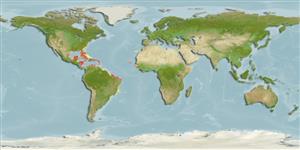Neopetrosia rosariensis (Zea & Rützler, 1983)
| Native range | All suitable habitat | Point map | Year 2050 |

|
| This map was computer-generated and has not yet been reviewed. |
| Neopetrosia rosariensis AquaMaps Data sources: GBIF OBIS |
Upload your photos
Google image |
No photo available for this species.No drawings available for Petrosiidae.
Google image |
No photo available for this species.
Classification / Names Common names | Synonyms | CoL | ITIS | WoRMS
| Haplosclerida | Petrosiidae
Environment: milieu / climate zone / depth range / distribution range Ecología
; rango de profundidad 2 - 30 m (Ref. 415). Tropical
Distribución Países | Áreas FAO | Ecosistemas | Ocurrencias, apariciones | Introducciones
Atlantic Ocean: Panama, Canary Islands and Colombia.
Length at first maturity / Tamaño / Peso / Age
Maturity: Lm ? range ? - ? cm Max length : 78.0 cm H macho / no sexado; (Ref. 415)
Short description Morfología
Cylindrical tubes: 4 - 78 cm high, 2 - 13 cm wide; emerge from basal mass. Dark reddish-brown externally, tan internally. Hard and dense. Smooth to the touch, with rugose and uneven parts, Sometimes covered by zooanthids. Oscules on the inner wall of tubes; 0.06 - 0.34 cm wide (Ref. 415).
On coral outcrops, and reef environments (Ref. 415).
Life cycle and mating behavior Madurez | Reproducción | Puesta | Huevos | Fecundidad | Larva
Members of the class Demospongiae are hermaphroditic. Life cycle: The zygote develops into parenchymella larva (free-swimming) before settling down on a substrate where it grows into a young sponge.
Main reference
Referencias | Coordinador | Colaboradores
Collin, R., M.C. Díaz, J. Norenburg, R.M. Rocha, J.A. Sánchez, M. Schulze, A. Schwartz and A. Valdés. 2005. (Ref. 415)
IUCN Red List Status (Ref. 130435)
CITES status (Ref. 108899)
Not Evaluated
CMS (Ref. 116361)
Not Evaluated
Threat to humans
Harmless
Human uses
| FishSource |
Herramientas
Más información
Países
Áreas FAO
Ecosistemas
Ocurrencias, apariciones
Introducciones
Stocks
Ecología
Dieta
componentes alimenticios
Áreas FAO
Ecosistemas
Ocurrencias, apariciones
Introducciones
Stocks
Ecología
Dieta
componentes alimenticios
Fuentes de Internet
BHL | BOLD Systems | CISTI | DiscoverLife | FAO(Publication : search) | Fishipedia | GenBank (genome, nucleotide) | GloBI | Gomexsi | Google Books | Google Scholar | Google | PubMed | Árbol de la vida | Wikipedia (Go, búsqueda) | Expediente Zoológico
Estimates based on models
Preferred temperature
(Ref. 115969): 23.7 - 28.3, mean 26.9 (based on 185 cells).
Price category
(Ref. 80766):
Unknown.


